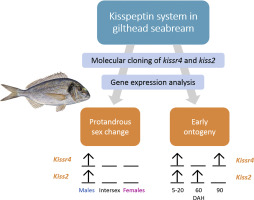当前位置:
X-MOL 学术
›
Comp. Biochem. Physiol. A Mol. Integr. Physiol.
›
论文详情
Our official English website, www.x-mol.net, welcomes your feedback! (Note: you will need to create a separate account there.)
Investigating the kisspeptin system in the hermaphrodite teleost gilthead seabream (Sparus aurata).
Comparative Biochemistry and Physiology A: Molecular & Integrative Physiology ( IF 2.3 ) Pub Date : 2019-12-06 , DOI: 10.1016/j.cbpa.2019.110624 Catarina C V Oliveira 1 , Elsbeth McStay 2 , Elsa Cabrita 1 , Maria Filipa Castanheira 1 , Hervé Migaud 2 , Maria Teresa Dinis 1 , Andrew Davie 2
Comparative Biochemistry and Physiology A: Molecular & Integrative Physiology ( IF 2.3 ) Pub Date : 2019-12-06 , DOI: 10.1016/j.cbpa.2019.110624 Catarina C V Oliveira 1 , Elsbeth McStay 2 , Elsa Cabrita 1 , Maria Filipa Castanheira 1 , Hervé Migaud 2 , Maria Teresa Dinis 1 , Andrew Davie 2
Affiliation

|
The kisspeptin system, a known regulator of reproduction in fish, was investigated during two key phases within the gilthead seabream (Sparus aurata) life cycle: protandrous sex change and larval ontogeny. Seabream specific partial cDNA sequences were identified for two key targets, kissr4 and kiss2, which were subsequently cloned and qPCR assays developed. Thereafter, to examine association in expression with sex change, a group of adult seabream (2+ years old) undergoing sex change were sampled for gene expression at two different periods of the annual cycle. To study the kisspeptin system ontogeny during early life stages, transcript levels were monitored in larvae (till 30 days-post-hatch, DPH) and post-larvae (from 30 till 140 DPH). During sex change, higher expression of kissr4 and kiss2 was observed in males when compared to females or individual undergoing sex change, this is suggestive of differential actions of the kisspeptin system during protandrous sex change. Equally, variable expression of the kisspeptin system during early ontogenic development was observed. The higher expression of kissr4 and kiss2 observed from 5 DPH, with elevations at 5-20 and 90 DPH for kissr4 and at 5, 10, 20, and 60 DPH for kiss2, is coincident with the early ontogeny of gnrh genes previously reported for seabream, and possibly related with early development of the reproductive axis in this species.
中文翻译:

研究雌雄同体硬骨银头鲷(Sparus aurata)中的kisseptin系统。
在银头鲷(Sparus aurata)生命周期的两个关键阶段,对亲鱼肽系统(已知的鱼类繁殖调节器)进行了研究:前性变性和幼虫发育。确定了两个主要靶标kisser4和kiss2的海鲷特异性部分cDNA序列,随后将其克隆并开发了qPCR分析法。此后,为了检查与性别变化的表达相关性,在一年周期的两个不同时期,对一组经历性别变化的成年鲷(2岁以上)进行基因表达采样。为了研究生命早期的kisepteptin系统个体发育,在幼虫(孵化后30天,DPH)和幼虫后(30至140 DPH)中监测转录水平。在改变性别时 与女性或经历性别改变的个体相比,男性中kissr4和kiss2的表达更高,这表明在前性别改变过程中kisepteptin系统的不同作用。同样,在早期个体发育过程中观察到了kisepteptin系统的可变表达。从5 DPH观察到kissr4和kiss2的较高表达,kissr4分别在5-20和90 DPH升高,而kiss2在5、10、20和60 DPH升高,这与先前报道的鲷鱼gnrh基因的早期发育相吻合。 ,并且可能与该物种生殖轴的早期发育有关。在早期个体发育过程中观察到了kisepteptin系统的可变表达。从5 DPH观察到kissr4和kiss2的较高表达,kissr4分别在5-20和90 DPH升高,而kiss2在5、10、20和60 DPH升高,这与先前报道的鲷鱼gnrh基因的早期发育相吻合。 ,并且可能与该物种生殖轴的早期发育有关。在早期个体发育过程中观察到了kisepteptin系统的可变表达。从5 DPH观察到kissr4和kiss2的较高表达,kissr4分别在5-20和90 DPH升高,而kiss2在5、10、20和60 DPH升高,这与先前报道的鲷鱼gnrh基因的早期发育相吻合。 ,并且可能与该物种生殖轴的早期发育有关。
更新日期:2019-12-06
中文翻译:

研究雌雄同体硬骨银头鲷(Sparus aurata)中的kisseptin系统。
在银头鲷(Sparus aurata)生命周期的两个关键阶段,对亲鱼肽系统(已知的鱼类繁殖调节器)进行了研究:前性变性和幼虫发育。确定了两个主要靶标kisser4和kiss2的海鲷特异性部分cDNA序列,随后将其克隆并开发了qPCR分析法。此后,为了检查与性别变化的表达相关性,在一年周期的两个不同时期,对一组经历性别变化的成年鲷(2岁以上)进行基因表达采样。为了研究生命早期的kisepteptin系统个体发育,在幼虫(孵化后30天,DPH)和幼虫后(30至140 DPH)中监测转录水平。在改变性别时 与女性或经历性别改变的个体相比,男性中kissr4和kiss2的表达更高,这表明在前性别改变过程中kisepteptin系统的不同作用。同样,在早期个体发育过程中观察到了kisepteptin系统的可变表达。从5 DPH观察到kissr4和kiss2的较高表达,kissr4分别在5-20和90 DPH升高,而kiss2在5、10、20和60 DPH升高,这与先前报道的鲷鱼gnrh基因的早期发育相吻合。 ,并且可能与该物种生殖轴的早期发育有关。在早期个体发育过程中观察到了kisepteptin系统的可变表达。从5 DPH观察到kissr4和kiss2的较高表达,kissr4分别在5-20和90 DPH升高,而kiss2在5、10、20和60 DPH升高,这与先前报道的鲷鱼gnrh基因的早期发育相吻合。 ,并且可能与该物种生殖轴的早期发育有关。在早期个体发育过程中观察到了kisepteptin系统的可变表达。从5 DPH观察到kissr4和kiss2的较高表达,kissr4分别在5-20和90 DPH升高,而kiss2在5、10、20和60 DPH升高,这与先前报道的鲷鱼gnrh基因的早期发育相吻合。 ,并且可能与该物种生殖轴的早期发育有关。



























 京公网安备 11010802027423号
京公网安备 11010802027423号